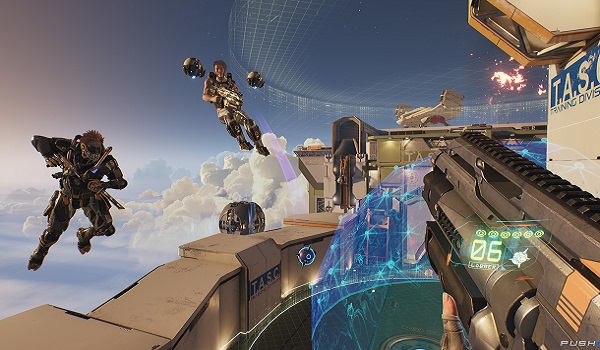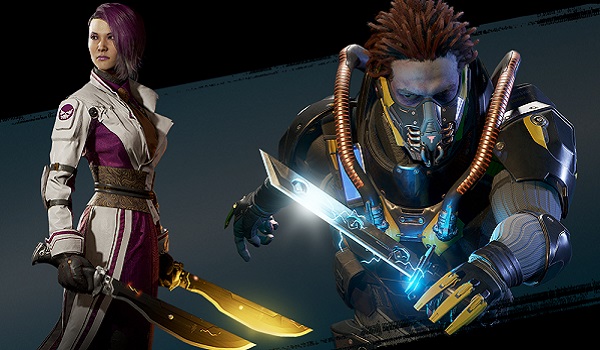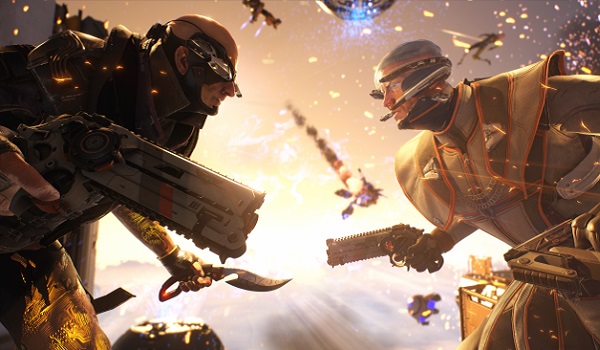LawBreakers Review: Teaching An Old Genre Some New Tricks

Arena shooters are a dime a dozen these days, so you wouldn't be faulted for taking a glance at LawBreakers and assuming it's yet another cookie-cutter addition to an increasingly crowded scene. Take it for a spin, though, and you might be surprised by the number of ways it sets itself apart from the pack.
In a post-Overwatch world, it's hard to talk about an arena shooter without drawing direct comparisons to that particular game. I'm only doing so now to say, "it ain't that game." LawBreakers does a good job of cutting its own path, emphasizing twitch shooting and mobility in game modes your average first-person shooter fan will be more accustomed to. If anything, LawBreakers has more in common with Unreal Tournament, another Cliff Bleszinski joint, than the vast majority of modern shooters.
Now that we've talked about what LawBreakers isn't, it's time to dig into what it actually is. In short, it's a fast-paced shoot-a-thon that rewards precision and character mastery in an FPS that boasts an extremely balanced roster, well-designed maps and a fantastic sense of mobility.
LawBreakers, as a package, is extremely straightforward. Out of the gate, your options are to jump into the regular map/mode rotation or set up a custom showdown to enjoy with your friends; and that's about it. Once you get rolling, there are nine character classes to choose from, eight maps to leap, warp and swing through, and a handful of game modes that put interesting spins on some genre favorites.
While the offerings aren't especially robust, everything here is extremely well-polished. It's easy to see why more than three years' worth of work has gone into LawBreakers even without a glut of modes, dozens of classes, or a single player campaign. It's not hard to imagine the team at Boss Key Productions creating a short, bulleted list of the things they wanted LawBreakers to achieve, then putting in the work necessary to do exactly those things very, very well.

Because of its unique spins on genre tropes, it will likely take you a few rounds of play to figure out the ins and outs of the game's various systems. You'll need a few rounds more to get the hang of your selected class, and a few rounds more to really start to figure out the intricacies of movement. With nine truly distinct classes on offer, you can pour a lot of hours into this game just trying to understand what makes each character tick. Sadly, I've been unable to find any sort of practice arena in the PlayStation 4 version of the game, so your options are to either jump into a match and learn the hard way, or set up a private match and jump in by yourself to tool around with the various roles.
Speaking of those character classes, you've got your pick of the Assassin, Battle Medic, Enforcer, Gunslinger, Harrier, Juggernaut, Titan, Vanguard and Wraith. Since this is a more realistic shooter in terms of aesthetics, the character designs are a bit bland when compared to other genre entries, but they all have some pretty unique skins available and a personality that starts to shine through once you've played them a few rounds. There's a little something for everyone here, too, whether you're new to the genre or an old hand. Traditional Call of Duty types will want to check out the Enforcer, who boasts an assault rifle, a sidearm, a sprint and a grenade. I've oversimplified the abilities here, but the point is that it's a good introductory class for an otherwise unique roster.
CINEMABLEND NEWSLETTER
Your Daily Blend of Entertainment News
Each character has three abilities, one of which usually being a nifty trick that helps them get around the arena faster. The Battle Medic, for instance, can take flight for a limited time while my beloved Wraith can slide across the ground. The Gunslinger has three short teleportations at their disposal while the Assassin -- who literally brought a knife to a gun fight -- has a tether they can use to swing from place to place.
The remaining abilities, just like everything else in the game, take mechanics you're likely familiar with and then turns them sideways. Going back to the Wraith, they've got a hell of a lot of mobility in exchange for not having a secondary weapon. The knife they use for a melee lunge, though, can fire its blade to stick into an opponent or a surface. From there, the blade will either detonate after a set period of time or can be shot to explode. I can't tell you how much fun it is to launch this "Stinger" into an opponent and watch as a teammate instantly shoots it, blowing the opponent sky high. It's great for defense, too, as you can tether it near an objective and then shoot it for detonation if an enemy strays too close.

I could spend another 5,000 words just going over abilities, but a huge part of the fun in LawBreakers is figuring out the classes for yourself. While there are only nine classes, there are actually two characters per class. Your character is determined by whether you're playing for the side of Law or Breakers but, while they look different, they are functionally identical.
What really sets LawBreakers apart from other modern arena shooters is that every class can go toe-to-toe with every other class. Knowing each class' strengths and weaknesses will enhance your odds of coming out victorious, but there's no clear OP badass in the bunch or matchups where one class knows they better run if they wind up going one-on-one with a specific opponent. Because of this, swapping roles mid-match is allowed and there's no limit on how many players can pick a given role.
As for the maps, you'll be riddling with bullets, LawBreakers boasts a set of futuristic arenas ranging from shopping malls and government outposts to mountain-side facilities and the like. Similar to the characters themselves, the setting is more grounded in reality and, as such, the visuals don't really stand out. That's not to say the game isn't lovely to look at, just that none of the maps really elicit a sense of awe. However, I'll take kinda bland settings so long as they're well designed, and that's indeed the case with LawBreakers. Each map is loaded with routes upon routes, with players needing to keep their head on a swivel if they don't want to chance a baddie dropping in from above or even popping up from below. All of the arenas also boast zones of low gravity, which make for some truly fantastic shootouts as you zip through the air, bounce off of walls and swing past your opponents, outgunning them mid-flight. You can even fire your weapon behind you, serving the double purpose of blind-firing on an enemy in pursuit or, for most classes, propelling you more quickly through the air.
Finally, there are the game modes, including Uplink, Blitzball, Turf War and Overcharge. As noted above, each of these modes puts a new spin on familiar objectives, making for a pretty fresh experience. Blitzball is not, in fact, a water sport pulled from Final Fantasy X. It's actually the most straightforward mode, requiring teams to battle over a single Blitzball located at the center of the map and then haul it to their enemy's base to score. Turf War is similar to zone control modes from other games, with the added wrinkle that the three zones refresh once they've all been controlled for a set period of time. Overcharge is probably the most white-knuckle mode. Teams battle over a single battery that holds its charge. The object of the mode is to charge the battery to 100 percent and then keep it locked at your base for 20 seconds. So while one team may grab the battery and charge it up to 75 percent, the other team may rush in for a steal, charge it the final 25 and then keep it locked at their base for 20 seconds to snatch the win.

Pull all of that together and you've got yourself a pretty stellar shooter that doesn't reinvent the wheel, but does manage to teach it to fly. Diverse loadouts, thoughtful map designs, fun game modes, and extremely tight controls make LawBreakers a killer FPS that any fan of the genre should pay attention to. On top of all of that, Boss Key has been extremely consumer friendly, with LawBreakers coming in at $30 on PC and PlayStation 4 and all future updates that aren't cosmetic being provided free-of-charge. This is a modern game, so of course there are Stash Drops to provide character and gun skins, stickers, player icons and the like, all of which you can grab for leveling up or by spending the in-game currency you earn while playing. Otherwise, you can drop a few extra bucks to get even more goodies.
My only real complaint is kind of a left-handed complement: While I'm enjoying the hell out of LawBreakers and feel there's plenty here to warrant the slimmer asking price, I was left wanting more. I want more characters, more modes, more maps and more reasons to keep coming back to the game. If Boss Key continues to provide those things, I think they have something pretty special on their hands.
This review based on a PlayStation 4 download copy provided by the publisher.
Staff Writer for CinemaBlend.
Joe Hendry Reveals How The WWE Snuck Him Into WrestleMania 41 For Randy Orton Match, And Confirms How Seriously They Take Surprise Appearances
Greg's Mom Seemed Like Another Nightmare 90 Day Fiancê Mother-In-Law, But She Changed My Mind
The Last Of Us Season 2 Episode 3 Live Blog: I'm Talking The Aftermath Of Joel's Tragedy, Ellie's Recovery And More










